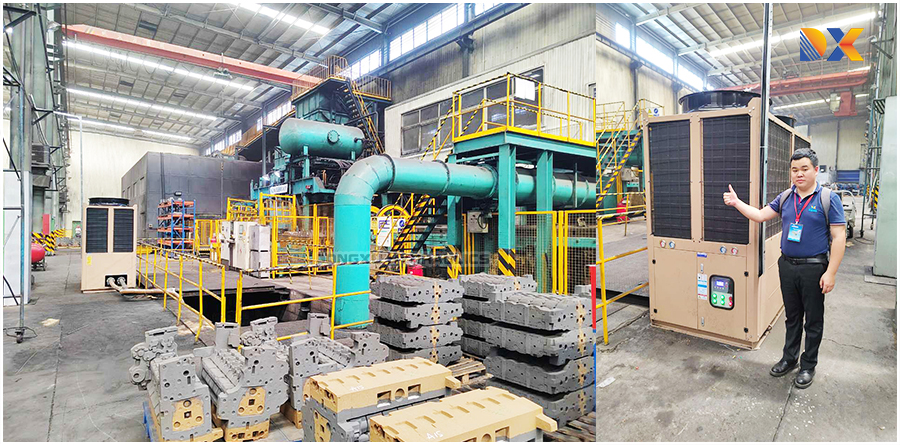Refrigeration working mode
Oil coolers usually operate in refrigeration mode. In this mode, the oil pump starts first, and the temperature controller simultaneously monitors the oil temperature and compares it with the refrigeration set temperature. When the measured oil temperature is higher than the refrigeration set temperature plus a temperature difference (internally set at 40°C), the refrigeration system activates. This cools down the higher-temperature oil entering the plate evaporator, which then returns to the oil tank to mix. This ensures that the oil temperature in the tank is controlled within the specified temperature range to meet the cooling equipment's requirements for oil temperature. When the measured oil temperature falls below the refrigeration set point, the refrigeration system ceases operation.
Heating working mode
When the oil cooler operates in heating mode, the oil pump runs and the temperature controller checks the oil temperature, comparing it with the heating set temperature. If the measured oil temperature is lower than the heating set point, the electric heater activates. This heats the lower-temperature oil passing through the electric heater before it returns to the oil tank, ensuring that the oil temperature in the tank doesn't get too low. When the measured oil temperature is higher than the heating set temperature plus a temperature difference (internally set at 20°C), the electric heater ceases operation.
Note: The temperature sensor that typically measures the oil temperature is installed on the oil cooler's inlet pipe, and the operation of the oil pump is not affected by temperature control. If the temperature sensor is externally installed for measuring the oil temperature within the oil tank, then the operation of the oil pump is controlled by temperature, similar to the cooling or heating system.

 GearboxesAgriculture/Products8
GearboxesAgriculture/Products8 GearboxesAgriculture/Products8
GearboxesAgriculture/Products8 GearboxesAgriculture/Products8
GearboxesAgriculture/Products8 GearboxesAgriculture/Products8
GearboxesAgriculture/Products8 GearboxesAgriculture/Products8
GearboxesAgriculture/Products8 GearboxesAgriculture/Products8
GearboxesAgriculture/Products8 GearboxesAgriculture/Products8
GearboxesAgriculture/Products8 GearboxesAgriculture/Products8
GearboxesAgriculture/Products8 GearboxesAgriculture/Products8
GearboxesAgriculture/Products8 GearboxesAgriculture/Products8
GearboxesAgriculture/Products8 GearboxesAgriculture/Products8
GearboxesAgriculture/Products8 GearboxesAgriculture/Products8
GearboxesAgriculture/Products8 GearboxesAgriculture/Products8
GearboxesAgriculture/Products8 GearboxesAgriculture/Products8
GearboxesAgriculture/Products8 GearboxesAgriculture/Products8
GearboxesAgriculture/Products8 GearboxesAgriculture/Products8
GearboxesAgriculture/Products8 GearboxesAgriculture/Products8
GearboxesAgriculture/Products8 GearboxesAgriculture/Products8
GearboxesAgriculture/Products8 GearboxesAgriculture/Products8
GearboxesAgriculture/Products8 GearboxesAgriculture/Products8
GearboxesAgriculture/Products8
